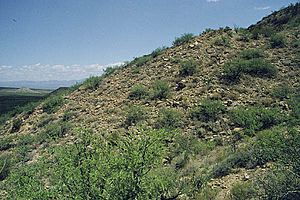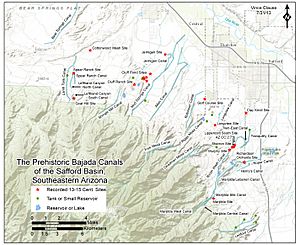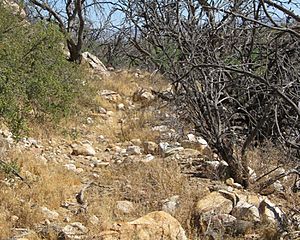Arizona bajada canals facts for kids
The Prehistoric Bajada "hanging" canals in southeastern Arizona are amazing ancient waterways. People built them around 1250 AD, and they were used until about 1450 AD. These canals helped ancient people bring water to their farms and homes.
Unlike other canals built along flat rivers, these "hanging" canals were built on the slopes of mountains, called bajadas. This shows how clever ancient people were at managing water in a dry climate. They used these canals to grow more food and live in more places.
Contents
Discovering Ancient Canals
These special ancient water systems have been found again in the Safford Basin of Arizona. So far, experts have found at least 28 "hanging" canal systems. Some of these canals are very long, up to 9.5 kilometers (about 6 miles)! If you add up all the parts, the total length is more than 80 kilometers (about 50 miles).
Most of these canals were built after 1250 AD and used until 1450 AD. A few might be even older, from around 800 AD.
Why Build "Hanging" Canals?
Some parts of these canals literally "hang" on the edges of steep, sloping landforms called mesas. These mesas are like flat-topped hills. The canals got their water from mountain streams, not big rivers. The water came from rain runoff, natural springs, and underground water sources.
These canals are also special because they go over bumpy, uneven mountain areas. Other ancient canals, like those built by the Hohokam people near Phoenix, usually stayed on flat river plains.
- High Up: In some places, these hanging canals are as high as 60 meters (about 197 feet) above the ground below.
- Smart Design: Builders chose the highest possible spots on the mesas for the canals. This helped them save energy and make the water flow efficiently.
- Independent Slope: A key reason for these unique routes was that the canal's slope could be controlled. It didn't have to follow the bumpy land around it.
- Easier Building: Building the canals across the land, rather than along it, saved a lot of effort. This also helped prevent water loss.
The canals were usually 0.3 to 1 meter (about 1 to 3 feet) wide and 20 to 40 centimeters (about 8 to 16 inches) deep. Some were even wider, up to 2 meters (about 6.5 feet). They were mainly used to carry water long distances to farm fields. Some canals also had ancient homes and farms right next to them.
How Do We Know Their Age?
Some parts of these canals still carry water today, especially where they have been rebuilt in more recent times. Many parts of the ancient canals are still in great condition. They are often filled with fine dirt. These canals are mostly on Arizona State and National Forest lands, which haven't been developed much. Even though they can be hard to reach, it's usually easy to follow the paths of the main canals.
Scientists have figured out the age of these canals in several ways:
- Layers of Earth: By studying the layers of soil and rock (called stratigraphy), they can see how old the canals are.
- Modern Changes: Some canals were built over by roads, dams, or even cemeteries, showing they were there first.
- Natural Growth: Old trees and shrubs growing in the middle of the canals, and natural coatings (like patina and caliche) on the rocks, show their age.
- No Modern Tools: There's no sign of modern tools being used to build them, except for places that were clearly fixed up later.
Who Lived Near the Canals?
Surveys in areas like Lefthand Canyon and Marijilda Canyon show that many people lived along these canals. However, their homes were usually small and spread out. Other canals had only a few small living sites nearby.
This suggests that the people who built and used these canals worked together in small groups. They didn't seem to have a very complex social system with different levels of power, like some other ancient cultures. This is similar to what has been found in the Hohokam area.
Trading and Connections
Pottery and house remains found at these ancient sites show that people traded with other groups. They also show that people from different cultures lived there. Besides the local Mogollon and Salado people, the expert canal builders of the Hohokam culture from the Phoenix area were also present.
It's likely that the local people in the Safford Basin designed and built some of the canals themselves. But the presence of Hohokam people suggests that they might have helped with the more advanced canal designs built later on.
Other Water Systems
The "hanging" canals are found in an area with other ancient water systems, both older and from the same time period. These include:
- Regular canals in the lowlands near rivers.
- Large dry farming fields with terraces and grids.
- Many small dams (called check dams).
- Small, single-room field houses.
- Groups of rock piles and rings used for farming.
No tools used for surveying (measuring land) have been found. But it's possible that the canals themselves, when partly filled with water, acted as a way to measure the land's level.
Building these canals took a huge amount of work. Experts believe it took about 50 years of human labor or even more! Because of their gentle, controlled slopes and the surrounding land, some parts of the system create a strong "water flowing uphill" illusion.
Other structures found with these canals include a long aqueduct (a bridge-like structure for carrying water) that crosses a low area, a deep and long ditch, and a canal segment that flows "counterflow" (against the main direction) up a canyon.
Images for kids
See Also







